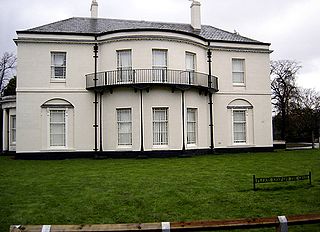
Batley is a market town in the Metropolitan Borough of Kirklees, in West Yorkshire, England. Batley lies south-west of Leeds, north-west of Wakefield and Dewsbury, south-east of Bradford and north-east of Huddersfield. Batley is part of the Heavy Woollen District. In 2011 the population of Batley including Hanging Heaton, Staincliffe, Carlinghow, Birstall, Birstall Smithies, Copley Hill and Howden Clough was 48,730.

Gomersal is a town in Kirklees in West Yorkshire, England. It is south of Bradford, east of Cleckheaton and north of Heckmondwike. It is close to the River Spen and forms part of the Heavy Woollen District.

Cleckheaton is a town in Kirklees, West Yorkshire, England. Historically part of the West Riding of Yorkshire, it is situated south of Bradford, east of Brighouse, west of Batley and south-west of Leeds. It is at the centre of the Spen Valley and was the major town in the former borough of Spenborough. Cleckheaton has a history as a mill town and forms part of the Heavy Woollen District.

The Brontës were a nineteenth-century literary family, born in the village of Thornton and later associated with the village of Haworth in the West Riding of Yorkshire, England. The sisters, Charlotte (1816–1855), Emily (1818–1848) and Anne (1820–1849), are well-known poets and novelists. Like many contemporary female writers, they published their poems and novels under male pseudonyms: Currer, Ellis, and Acton Bell. Their stories attracted attention for their passion and originality immediately following their publication. Charlotte's Jane Eyre was the first to know success, while Emily's Wuthering Heights, Anne's The Tenant of Wildfell Hall and other works were accepted as masterpieces of literature after their death.

Heckmondwike is a town in the metropolitan borough of Kirklees, West Yorkshire, England, 9 miles (14 km) south west of Leeds. Historically part of the West Riding of Yorkshire, it is close to Cleckheaton and Liversedge. It is mostly in the Batley and Spen parliamentary constituency, and had an estimated population of 16,986 at the 2011 Census increasing to 18,149 at the 2021 Census. Heckmondwike forms part of the Heavy Woollen District.

Shirley, A Tale is a social novel by the English novelist Charlotte Brontë, first published in 1849. It was Brontë's second published novel after Jane Eyre. The novel is set in Yorkshire in 1811–12, during the industrial depression resulting from the Napoleonic Wars and the War of 1812. The novel is set against the backdrop of the Luddite uprisings in the Yorkshire textile industry.

Liversedge is a town and former parish of Birstall, in the metropolitan borough of Kirklees, West Yorkshire, England. Historically part of the West Riding of Yorkshire, Liversedge lies between Cleckheaton and Heckmondwike. The Kirklees ward is now called Liversedge and Gomersal with a population at the 2011 Census of 19,420. Liversedge forms part of the Heavy Woollen District.

Patrick Brontë was an Irish Anglican minister and author who spent most of his adult life in England. He was the father of the writers Charlotte, Emily, and Anne Brontë, and of Branwell Brontë, his only son. Patrick outlived his wife, the former Maria Branwell, by forty years, by which time all of their six children had died as well.

Oakwell Hall is an Elizabethan manor house in Birstall, West Yorkshire, England. The Grade I listed hall is set in period gardens surrounded by 110 acres (0.45 km2) of country park.

The A638 is a major road in England. It runs between the A1 at Markham Moor, Nottinghamshire and Chain Bar Interchange – Junction 26 of the M62 motorway, south of Bradford in West Yorkshire.
Spen Valley was a parliamentary constituency in the valley of the River Spen in the West Riding of Yorkshire. It returned one Member of Parliament (MP) to the House of Commons of the Parliament of the United Kingdom.

Luke Burgess is an English former professional rugby league footballer who last played for the Salford Red Devils in the Super League. Luke Burgess is the brother of fellow rugby league players Sam, George and Tom Burgess. He previously played in the NRL for the South Sydney Rabbitohs and the Manly-Warringah Sea Eagles.

Bilton Hall is a 17th-century mansion house in the Bilton area of Rugby, Warwickshire which has been converted into residential apartments. It is a Grade I listed building. It was once the home of the poet and essayist Joseph Addison and of the sporting writer Charles James Apperley.

Theodore Cooke Taylor was a British businessman and Liberal politician. He was best known for pioneering profit-sharing in his business activities and for leading a movement against the opium trade.

Amos Starr Cooke was an American educator and businessman in the Kingdom of Hawaii. He was patriarch of a family that influenced Hawaii during the 20th century.

Parrs Wood House is an 18th-century Georgian villa in the Parrs Wood area of Didsbury, Manchester, England. It was described by Pevsner as "a poorer man's Heaton Hall." It was designated a Grade II* listed building on 25 February 1952.
Michael Gutteridge (1842–1935) was an English Methodist and businessman who founded a successful drapery business in Naples, and the Wesley House seminary in Cambridge, England. The Italian fashion brand Gutteridge still exists, using the strapline "dal 1878" as part of its image.


















